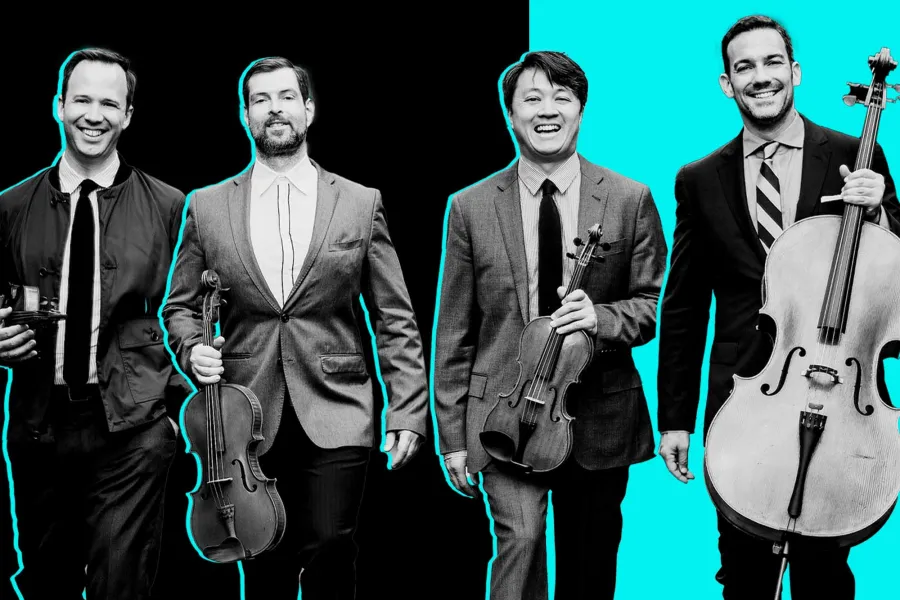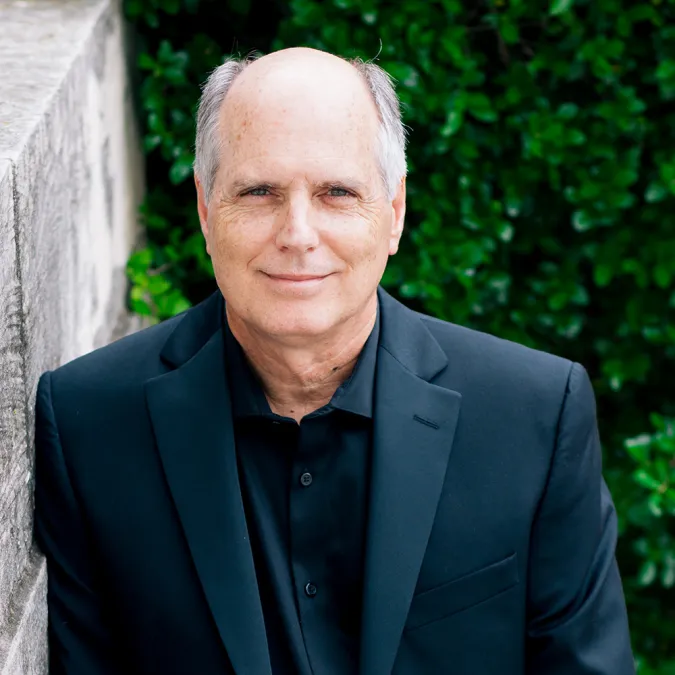
Daniel Ching, violin
William Fedkenheuer, violin
John Largess, viola
Joshua Gindele, cello
featuring Rick Rowley, piano
This concert will last approximately 100 minutes, with 1 intermission.
Program
W.A. Mozart
Piano Quartet in E-Flat Major, K. 493
I. Allegro
II. Larghetto
III. Allegretto
William Fedkenheuer, violin
John Largess, viola
Joshua Gindele, cello
Rick Rowley, piano
Alberto Ginastera
String Quartet No. 1, Op. 20
I. Allegro violente ed agitato
II. Vivacissimo
III. Calmo e poetico
IV. Allegramente rústico
intermission
Ludwig van Beethoven
String Quartet in F Major, Op. 135
I. Allegretto
II. Vivace
III. Lento assai, cantante e tranquillo – più lento
IV. "Der schwer gefaßte Entschluß” (The difficult question): Grave, ma non troppo tratto, "Muss es sein?” (Must it be?) – Allegro, "Es muss sein!” (It must be!)
About The Program
W.A. Mozart
Piano Quartet in E-Flat Major, K. 493
BORN January 27, 1756, Salzburg, Germany
DIED December 5, 1791, Vienna, Austria
COMPOSED 1786
To be delivered from the stage.
Alberto Ginastera
String Quartet No. 1, Op. 20
BORN April 11, 1916, Buenos Aires, Argentina
DIED June 25, 1983, Geneva Switzerland
COMPOSED 1948, Buenos Aires, Argentina
DURATION 20 minutes
The endeavor of analyzing a composer’s output is nearly always a posthumous one, left for musicologists and historians. So, it was unusual when Argentine composer Alberto Ginastera divided his own artistic output into three distinct time periods: Objective Nationalism (1934–1948), Subjective Nationalism (1948–1958), and Neo-Expressionism (1958–1983). Throughout his lifetime, Ginastera was committed to showcasing the music of his homeland, and as he matured, so did his view of Argentina, and the musical language he used to depict it. His first string quartet is considered a transitional work, having been completed in 1948, as the composer was shifting from objective to subjective nationalism. Ginastera described it as a “time to drop ethnic realism in favor of the creation of an imagined folklore.” He used nearly the same language in describing his quartet, writing in the inscription: “It consists of the usual four movements—Allegro, Scherzo, Adagio and Rondo— wherein rhythms of Argentine folk music can still be perceived through a re-creation of an imaginary folklore.” He went on to say, “In this quartet I find that some characteristics of my own artistic personality materialize for the first time: strong and incisive rhythms, adagios that are anxiety-ridden, lyrical, and contemplative; and atmospheres that are mysterious, nocturnal, and surrealistic.” The work, which still offered allusions to the iconic gauchos on horseback, and the great pampas plains regions of his earlier music, now was influenced by the likes of Stravinsky and Bartók. It garnered immediate acclaim. and was awarded the first ever “Carlo Lopez Buchardo Prize” by the Wagnerian Society of Buenos Aires, named in memory of the Argentine composer Buchardo who was a mentor to Ginastera during his studies at the Conservatorio Nacional de Música.
– Mark Bilyeu
Ludwig van Beethoven
String Quartet in F Major, Op. 135
BORN 1770, Bonn, Germany
DIED March 26, 1827, Vienna, Austria
COMPOSED October, 1826
DURATION 25 minutes
By August of 1826 the situation with Beethoven’s nephew had reached its own desperate climax. Beethoven had forcibly wrested the guardianship of his nephew from his sister-in-law Johanna several years previously after the untimely death of his brother. Beethoven had brought up this teenage boy to have the strongest antipathy to Karl’s mother, but at the same time the boy rebelled against the harsh strictness and even cruelty of his uncle, clearly feeling estranged from both. Now, at age eighteen, this young man was a simmering stew of resentment and anger, and his sanity had reached a breaking point. On August 5, Karl snapped: he pawned his watch, bought a pistol, and having written a suicide note, climbed a hill and shot himself in the head. Unbelievably, he failed to kill himself, and wounded with a bullet in his skull, he was taken by a stranger to his mother’s house in Vienna, where his uncle found him. This is perhaps the most shocking incident of Beethoven’s entire personal life, all the more so because he held himself emotionally responsible for this boy he thought of as his son. His last dream of family happiness lay in bloody ruins at his feet, and at long last Beethoven was forced to see himself and his family in a harsh, but mercilessly truthful light. It was time for Beethoven to let go.
For the next three months Beethoven and Karl retired to the village of Gneixendorf in the Vienna countryside, to talk and to heal; it is a tentative time of reconciliation and rediscovery. As Karl’s wounds scar and his hair grows back, arrangements are made to save him from the personal scandal created by his suicide attempt: he will leave Vienna and enlist in the military, an idea that he himself embraced with excitement. It is also during these suddenly quiet months of personal reflection that the last works of Beethoven’s last year were written: the Opus 135 quartet and the replacement finale for the Opus 130 quartet. Perhaps unsurprisingly under the circumstances, both these pieces share a lightness and a sense of release that was not heard in the quartets of the previous year; one might even hear in them a return to a certain pastoral spirit and simplicity. Nonetheless, the slow movement of Opus 135 is weighty with a sense of farewell, perhaps both to his nephew and to his own dreams. The final movement of Opus 135, entitled Muss es sein? (Must it be?) is saturated with both deep pain and a giddy sense of final relief. The twinges of humor, the feeling of release, the playful acceptance, and the simplicity of this lone movement echo the final bars of Es muss sein! in its joyful mystery. There is even a sense of miraculous expectation that the two movements share...we are turning the final corner, and what is about to come next?
The emotional drain of these months was to prove the final straw that broke the camel’s back as far as Beethoven’s health was concerned. By December Beethoven was coughing up blood, having difficulty breathing, progressively less able to move, with swollen painful limbs and abdomen. It was clear to his doctors and friends that there was nothing to be done, and that years of poor physical health and emotional strain were coming to their inevitable climax. Each week that passed brought the composer greater weakness and greater physical suffering, and by March 26th, 1827, Beethoven at age 56 was dead.
– John Largess
About the artists

Rick Rowley
Rick Rowley has given concerts with many of the world’s finest instrumentalists and singers and his performances have taken him throughout the United States, to Europe and Latin America. He has recorded several highly praised solo recordings, as well as chamber music and songs for voice and piano. He is the recipient of the Austin Critics’ Table award for Instrumentalist of the Year and one of the 10 Best Performances of Music and Dance by the Austin Chronicle. Rowley is on the Faculty of the Butler School of Music where he coaches singers, works with collaborative pianists and has taught a variety of classes ranging from Art Song Literature to a History of Broadway. He spent many years in the theater and was involved in over 60 productions as actor, music director and director.
Miró Quartet

The Miró Quartet is one of America’s most celebrated and dedicated string quartets, having been labeled by The New Yorker as “furiously committed” and noted by the Cleveland Plain Dealer for its “exceptional tonal focus and interpretive intensity.” For over twenty-five years the Quartet has performed throughout the world on the most prestigious concert stages, earning accolades from critics and audiences alike. Based in Austin, TX, and thriving on the area’s storied music scene, the Miró takes pride in finding new ways to communicate with audiences of all backgrounds while cultivating the longstanding tradition of chamber music.
In their 2023-24 season, the Miró Quartet embarks on a new performance and recording project with pianist Lara Downes. Here on Earth features musical depictions of planet earth, its evolution, and the lives of its inhabitants, with works spanning a century of cultural shift that begins with Darius Milhaud’s La Création du Monde, performed in a new arrangement for piano and string quartet. Upcoming performances include the premiere of a new version of Kevin Puts’ Credo with the Naples Philharmonic, as well as performances for the Chamber Music Society of Lincoln Center, the Mondavi Center for the Performing Arts, the Saratoga Perfoming Arts Center, and Premiere Performances in Hong Kong.
Miró Quartet took its name and its inspiration from the Spanish artist Joan Miró, whose Surrealist works — with subject matter drawn from the realm of memory, dreams, and imaginative fantasy — are some of the most groundbreaking, influential, and admired of the 20th century.
UPCOMING EVENTS
Sandy Yamamoto & Friends
Sunday, September 22, 3:00 p.m.
Bates Recital Hall
Bion Tsang, cello
& Anton Nel, piano
Wednesday, October 2, 7:30 p.m.
Bates Recital Hall
Symphony Orchestra
Saturday, October 26, 7:30 p.m.
Bates Recital Hall
Miró Quartet
with Masumi Per Rostad, viola
Monday, October 28, 7:30 p.m.
Miró Quartet
with Anton Nel, piano
Friday, January 24, 7:30 p.m.
Event Details
$10–20
All University of Texas at Austin students are allowed one free ticket as long as they are available. Student tickets must be picked up at the Box Office with valid student I.D. Seating is unassigned.
If you are a patron with ADA needs, please email tickets@mail.music.utexas.edu and we will reserve ADA seating for you.

